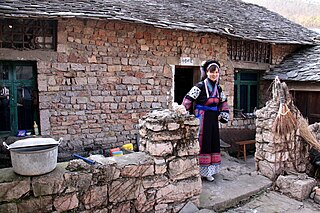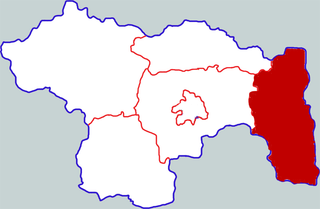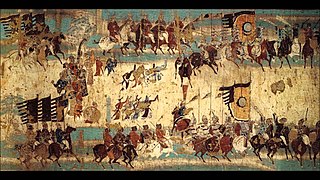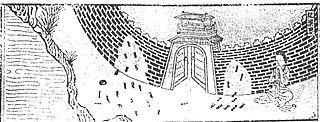Related Research Articles

The Zhuang ; Sawndip: 佈獞) are a Tai-speaking ethnic group who mostly live in the Guangxi Zhuang Autonomous Region in Southern China. Some also live in the Yunnan, Guangdong, Guizhou, and Hunan provinces. They form one of the 56 ethnic groups officially recognized by the People's Republic of China. With the Bouyei, Nùng, Tày, and other Northern Tai speakers, they are sometimes known as the Rau or Rao people. Their population, estimated at 18 million people, makes them the largest minority in China.

Guilin, formerly romanized as Kweilin, is a prefecture-level city in the northeast of China's Guangxi Zhuang Autonomous Region. It is situated on the west bank of the Li River and borders Hunan to the north. Its name means "forest of sweet osmanthus", owing to the large number of fragrant sweet osmanthus trees located in the region. The city has long been renowned for its scenery of karst topography.

The Bouyei, otherwise known as the Zhongjia, are an ethnic group living in Southern Mainland China. Numbering 2.5 million, they are the 11th largest of the 56 ethnic groups officially recognized by the People's Republic of China.

The Liang dynasty, alternatively known as the Southern Liang or Xiao Liang in historiography, was an imperial dynasty of China and the third of the four Southern dynasties during the Northern and Southern dynasties period. It was preceded by the Southern Qi dynasty and succeeded by the Chen dynasty. The rump state of Western Liang existed until it was conquered in 587 by the Sui dynasty.
For most of its history, China was organized into various dynastic states under the rule of hereditary monarchs. Beginning with the establishment of dynastic rule by Yu the Great c. 2070 BC, and ending with the abdication of the Xuantong Emperor in AD 1912, Chinese historiography came to organize itself around the succession of monarchical dynasties. Besides those established by the dominant Han ethnic group or its spiritual Huaxia predecessors, dynasties throughout Chinese history were also founded by non-Han peoples.

Li Jing, courtesy name Yaoshi, posthumously known as Duke Jingwu of Wei, was a Chinese military general, strategist, and writer who lived in the early Tang dynasty and was most active during the reign of Emperor Taizong. In 630, Li Jing defeated the Göktürks, led by Jieli Khan, with just 3,000 cavalry soldiers in a surprise attack, allowing the Tang Empire to subjugate the Göktürks and reduce them to the status of a vassal under the Tang Empire. Li Jing and Li Shiji are considered the two most prominent early Tang generals.

The Historical Records of the Five Dynasties is a Chinese history book on the Five Dynasties period (907–960), written by the Song dynasty official Ouyang Xiu in private. It was drafted during Ouyang's exile from 1036 to 1039 but not published until 1073, a year after his death. An abridged English translation by Richard L. Davis was published in 2004.

Cihang Zhenren is a Daoist deity and character in the classic Chinese novel Investiture of the Gods. He is a disciple of Yuanshi Tianzun and one of the Three Great Immortals, holding the ninth position among the Twelve Golden Immortals.
Tianyang District is a district in western Guangxi, China. It is under the administration of the prefecture-level city of Baise.

Yanling County is a county in the central part of Henan province, China. It is the easternmost county-level division of the prefecture-level city of Xuchang.

Standard Zhuang is the official standardized form of the Zhuang languages, which are a branch of the Northern Tai languages. Its pronunciation is based on that of the Yongbei Zhuang dialect of Shuangqiao Town in Wuming District, Guangxi with some influence from Fuliang, also in Wuming District, while its vocabulary is based mainly on northern dialects. The official standard covers both spoken and written Zhuang. It is the national standard of the Zhuang languages, though in Yunnan a local standard is used.

The Beiting Protectorate-General, initially the Beiting Protectorate, was a Chinese protectorate established by the Tang dynasty in 702 to control the Beiting region north of Gaochang in contemporary Xinjiang. Wu Zetian set up the Beiting Protectorate in Ting Prefecture and granted it governorship over Yi Prefecture (Hami) and Xi Prefecture (Gaochang). The Beiting Protectorate ended in 790 when Tingzhou was conquered by the Tibetan Empire. The ruins, along with other sites along the Silk Road, were inscribed in 2014 on the UNESCO World Heritage List as the Silk Roads: the Routes Network of Chang'an-Tianshan Corridor World Heritage Site.

Lady Meng Jiang or Meng Jiang Nü is a Chinese tale with many variations. Later versions are set in the Qin dynasty, when Lady Meng Jiang's husband was pressed into service by imperial officials and sent as corvee labor to build the Great Wall of China. Lady Meng Jiang heard nothing after his departure, so she set out to bring him winter clothes. Unfortunately, by the time she reached the Great Wall, her husband had already died. Hearing the bad news, she wept so bitterly that a part of the Great Wall collapsed, revealing his bones.

Sawgoek or sawva was a mythological ancient script mentioned in the Zhuang creation epic Baeu Rodo. The primordial god Baeu Ro was said to have brought sawgoek containing four thousand glyphs along with fire to the Zhuang people. However, in their unfamiliarity with fire, the people stored the fire under a thatched roof, causing the house to catch on fire. The sawgoek was consumed in the ensuing conflagration, and knowledge of writing was lost. Some Zhuang scholars believe that this myth stems from a vague remembrance of sawgoek in the collective consciousness of the Zhuang people long after knowledge of the writing system had been forgotten.
The Zhuang have a rich variety of customs and culture.
"The Legend of Wenlong" is an ancient folk story of Han Chinese origin, that was early on adopted by several people groups in Southern China including the Zhuang. It is also known by the name of the associated Chinese opera Liu Wenlong and the Water-chestnut Mirror. It is now a traditional song of the Zhuang people that is sung at the Dragon Boat Festival in some places.

Sawndip are Chinese characters used to write the Zhuang languages in the Chinese provinces of Guangxi and Yunnan. The script has been used not only by the Zhuang people but also by the closely related Bouyei in Guizhou, China; the Tay in Vietnam; and the Nùng in Yunnan, China, and Vietnam. Sawndip is a Zhuang word that means "immature characters". The Zhuang word for Chinese characters used in the Chinese languages is sawgun ; gun is the Zhuang term for the Han Chinese. Even now, in traditional and less formal domains, Sawndip is more often used than alphabetical scripts.

Xiangji Temple is a Buddhist temple located in Chang'an District of Xi'an, Shaanxi. The temple is regarded as the cradle of Pure Land Buddhism.
Li Bing, was a Chinese politician of the Northern Zhou dynasty, during the Northern and Southern dynasties period. He was the father of Gaozu, the founding emperor of the Tang dynasty.

Tongtianguanfu is a form of court attire in hanfu which was worn by the emperor during the Song dynasty on very important occasions, such as grand court sessions and during major title-granting ceremonies. The attire traces its origin from the Han dynasty.It was also worn in the Jin dynasty emperors when the apparel system of the Song dynasty was imitated and formed their own carriages and apparel system, and in the Ming dynasty. The tongtianguanfu was composed of a red outer robe, a white inner robe, a bixi, and a guan called tongtianguan, and a neck accessory called fangxin quling.
References
- ↑ Liang, Tingwang (2007). 壮文论集 Anthology of Written Zhuang by 梁庭望. 中央民族大学出版社 Central Minorities University Press. pp. 153–158. ISBN 9787811084368.
- ↑ Liáng, Tíngwàng 梁庭望 (2005). 壮族伦理道德长诗传扬歌译注. pp. 5–81. 广西民族出版社
- ↑ 广西民间故事(二). pp. 7–8.
- ↑ 周作秋. 壮族文学发展史 (上册). p. 416.
- ↑ 广西大百科全书 Encyclopedia of Guangxi. Vol. 5. p. 445. ISBN 9787500079729.
- ↑ 朱恒夫. 清代戏曲抄本叙录 A Catalogue of Qing Dynasty Opera Manuscripts.
- ↑ Liao Songs of Pingguo Zhuang Songs of March page 60 ISBN 978-7-5495-1097-9
- ↑ Liao Songs of Pingguo Zhuang Songs of March pages 56 ISBN 978-7-5495-1097-9
- ↑ 广西民间故事(二) pages 129-133